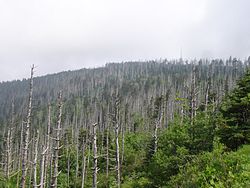Oh, Christmas Tree: Finding and Saving the Fraser Fir
Choosing and decorating a Christmas tree is one of my favorite holiday traditions, and this weekend we plan to set out to a South Jersey farm to find our tree. If you don't buy from local farms, you risk buying a tree that's been trucked down from Maine or Canada, which means more gas and pollution. My original plan for this post was to share all of the farms where you can find Jersey-grown trees, but instead I'll just point you to NJChristmasTrees.org and tell you we're going to Spruce Goose Farms in Chesterfield.One quick note: Buying real trees is much more eco-friendly than buying a fake one to be used year after year, because those trees eventually end up in landfills. Imagine a massive, growing pile of sparkling plastic trees never to decompose. Sorry for that visual, but yeah, the truth is sometimes depressing. Trees from tree farms are a renewable, sustainable and recyclable resource. The family that runs Spruce Goose Farms is committed to improving wildlife habitats in New Jersey, as well, which makes me extra excited to support them. From the Spruce Goose website:"We promote the many benefits our trees and farm provide such as clean air, water, wildlife habitats, recreation and environmental education. We believe we all share the responsibility to manage and sustain a healthy, green and growing NJ!"So like I said, I was going to tell you about all of the varieties you can find in our fine state and where to get them, but then, over my morning coffee(s), I ended up far down one of those Internet black holes after doing a little bit of research into our favorite Christmas tree, the Fraser fir.

